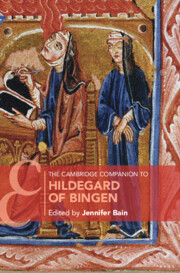Book contents
- The Cambridge Companion to Hildegard of Bingen
- The Cambridge Companion to Hildegard of Bingen
- Copyright page
- Dedication
- Contents
- Figures
- Tables
- Music Examples
- Contributors
- Acknowledgments
- Introduction
- Part I Life and Monastic Context
- Part II Writings and Reputation
- Chapter 4 Hildegard of Bingen’s Theology
- Chapter 5 Reading Hildegard of Bingen’s Letters
- Chapter 6 From the Roots to the Branches: Greenness in the Preaching of Hildegard of Bingen and the Patriarchs
- Chapter 7 Hildegard of Bingen: Illness and Healing
- Chapter 8 The Pentachronon and Hildegard of Bingen’s Reputation As a Prophet
- Chapter 9 The Context and Reception of Hildegard of Bingen’s Visions
- Part III Music, Manuscripts, Illuminations, and Scribes
- Select Bibliography
- Index
- Cambridge Companions To …
- References
Chapter 5 - Reading Hildegard of Bingen’s Letters
from Part II - Writings and Reputation
Published online by Cambridge University Press: 28 October 2021
- The Cambridge Companion to Hildegard of Bingen
- The Cambridge Companion to Hildegard of Bingen
- Copyright page
- Dedication
- Contents
- Figures
- Tables
- Music Examples
- Contributors
- Acknowledgments
- Introduction
- Part I Life and Monastic Context
- Part II Writings and Reputation
- Chapter 4 Hildegard of Bingen’s Theology
- Chapter 5 Reading Hildegard of Bingen’s Letters
- Chapter 6 From the Roots to the Branches: Greenness in the Preaching of Hildegard of Bingen and the Patriarchs
- Chapter 7 Hildegard of Bingen: Illness and Healing
- Chapter 8 The Pentachronon and Hildegard of Bingen’s Reputation As a Prophet
- Chapter 9 The Context and Reception of Hildegard of Bingen’s Visions
- Part III Music, Manuscripts, Illuminations, and Scribes
- Select Bibliography
- Index
- Cambridge Companions To …
- References
Summary
This chapter explains the significance of Hildegard of Bingen’s letter collection for her public career and for understanding why she wrote letters, why editors collected them, and why readers desired to receive them. It places the letters into the larger context of letter-writing in the twelfth century; like her contemporaries, Hildegard saw letters as the most effective way to publicize her work, but the prophetic style in which she wrote them made them unique and particularly desirable for correspondents. The chapter describes how editors and collaborators gathered her letters into a formal, edited collection that would serve as a record of the widespread and beneficial impact of her prophecy and examines the relationship between Hildegard and her correspondents. The incoming letters reveal that people from all walks of life looked to Hildegard as a source of life-changing spiritual power, while Hildegard’s responses show her wielding that power in a responsible and orthodox manner. The chapter argues that Hildegard’s letter collection offers a unique perspective on the seer, one that brings us closer to the experience of her prophetic career than any other part of her corpus.
- Type
- Chapter
- Information
- The Cambridge Companion to Hildegard of Bingen , pp. 105 - 124Publisher: Cambridge University PressPrint publication year: 2021



